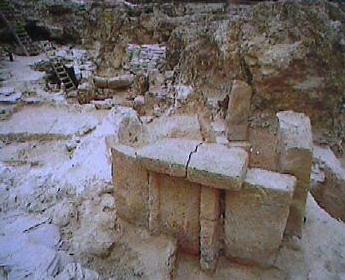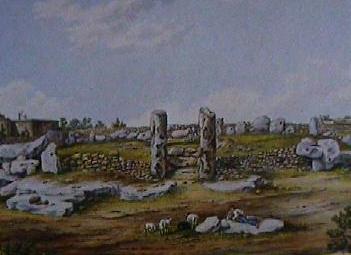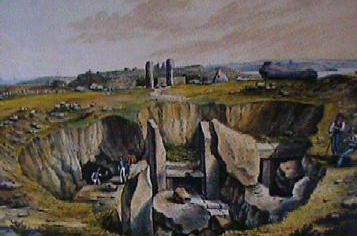|
Location:
Tal Qacca, Gozo. |
Grid Reference:
36.05� N. 14.26� E. |

 The
Xaghra Circle:
(Brochtorff Circle).
The
Xaghra Circle:
(Brochtorff Circle).
The Xaghra circle has been
known about for a long time but in 1987-94, following a dig by
a joint team from the University of Malta, the Maltese Museums Department
and the University of Cambridge, the site had life breathed into it once more.
The excavation uncovered the burial ground of the same community (Hypogeum
II), which practised its rituals in the nearby Ggantija temple, dating
principally to the period from 3000 to 2400 BC. The most notable discoveries
include more than 200,000 human body parts and prehistoric art relating to the
builders of the prehistoric Maltese temples
An earlier chambered tomb on the site dates to the period between
4,100 and 3,800 BC.
(Click
here for images of the reconstructed site)
In the 1820s, the Lieutenant Governor of Gozo, Otto
Bayer conducted an "excavation" at the circle which was recorded by the local
artist Charles de Brochtorff in 1825 (below).


These watercolours are by Charles Brochtorff and show the circle before and
after the 1826 excavation.
(Note - the alignment between the two 'Portal' stones above ground, and the
larger uprights below).
The stone circle above ground
enclosed a ritual area, entered through a huge stone entrance which led the
mourners across a stone threshold and probably down steps into the rugged
caves. At the centre, was an area enclosed by elegant megalithic trilithon
altars and a massive stone bowl. The many natural caverns and niches of the
caves were divided off by walls and stone slabs.

A photo of the
Hypogeum II, found underneath the Xaghra
Circle.
The full
analysis of the circle�s bones has shown there are 220,000 body parts buried
there, mostly small bits of bone. The circle itself was a colossal
collection of ancestors. Some 800 skulls were found � this gives an inkling
of the quantity of the bodies originally buried there. Interestingly, and
curiously, the bodies seem to have been moved around. Some bodies remained
intact � these were mainly male (thus undermining the goddess theory Dr
Stoddart said and concurring with Dr Malone), while other bodies were
sectioned off: the skulls collected at the top, the limbs on one side and
the other bits on the other side. Some male corpses have older male corpses
(ancestors) on top of them. This burial ground thus preserves the memory of
male ancestors. In a few cases, where some intact corpses were found, the
man seems to have been buried first, followed by a woman.
(Ref: http://www.desertfoxoverland.co.uk/malta_-_news_article.HTM
)
Myth and Legend -
Hancock
(1), makes mention
of another stone circle that is rumoured to have once existed in the channel
between Malta and Comino. He writes that he once talked directly with
one of the commercial divers who saw the structure before it was 'buried by developers beneath concrete pilings'.
Alignments
-
An alignment is suggested between the
trilithon underground, and the 'portal' stones of the stone circle (see Brochtorff's pictures above).
(Other Maltese sites)
|